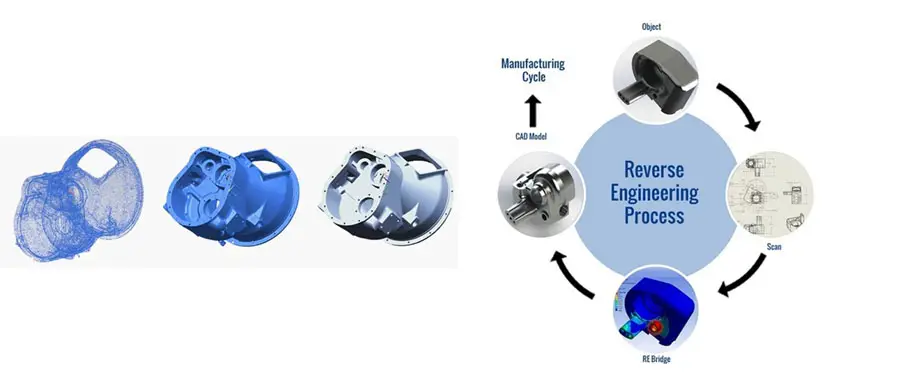Reverse engineering is the process of deconstructing a product to understand its design, functionality, and manufacturing methods. It involves disassembling the product, analyzing its components, and documenting its structure and operation. By performing reverse engineering, engineers can gain valuable insights into the design principles and techniques used in the product, which can be applied to improve existing products or develop new ones.

There are several advantages to using reverse engineering for product design improvement. First, it allows engineers to identify areas where the product can be improved. By identifying weaknesses or inefficiencies in the design, engineers can develop modifications to address these issues and enhance the overall performance or functionality of the product.

Second, reverse engineering can help identify cost-saving opportunities. By understanding the manufacturing methods and material choices used in the product, engineers can identify areas where alternative or more efficient processes or materials can be used to reduce production costs.

Third, reverse engineering can provide valuable insights into the latest trends and technologies in the industry. By analyzing competitors’ products, engineers can identify emerging technologies or design features that can be incorporated into their own products to stay competitive and at the forefront of innovation.
However, it’s crucial to note that reverse engineering may raise ethical and intellectual property concerns. It is essential to ensure that the product being reverse engineered is not protected by intellectual property rights, patents, or copyrights. It is also important to respect the original designer’s rights and acknowledge their contribution.
Overall, reverse engineering can be a powerful tool for product design improvement. It can provide valuable insights into the strengths and weaknesses of existing products, identify cost-saving opportunities, and keep engineers updated on the latest technologies. However, it’s essential to use reverse engineering ethically and responsibly, respecting the rights of the original designer.Title: Using Reverse Engineering To Improve Product Design
Executive Summary
Reverse engineering is a process of taking an existing product apart and analyzing its components and features to understand how it works and how it was made. This information can then be used to create a new product that is similar to the original product, but with improved features and functionality. Reverse engineering can be a valuable tool for product designers, as it can help them to identify areas where an existing product can be improved, and it can also help them to develop new and innovative products.
Introduction
Reverse engineering is a process that has been used for centuries to create new products and technologies. It is a powerful tool for product designers as it allows them to learn from the successes and failures of existing products, and it can help them to develop new and innovative products that are better suited to the needs of consumers.
5 Key Steps to Reverse Engineering for Product Design
1. Choosing the Right Product to Reverse Engineer
The first step is to choose the right product to reverse engineer. The product should be one that is successful, well-made, and has features that can be improved. It is also important to choose a product that is not too complex or expensive to reverse engineer.
2. Disassembling the Product
Once the product has been selected, it is time to disassemble it. This can be done by following the instructions in the product manual or by using a reverse engineering tool. It is important to be careful when disassembling the product to avoid damaging it.
3. Analyzing the Product’s Components
Once the product has been disassembled, it is time to analyze its components. This can be done by examining the components visually, by taking measurements, and by conducting tests. The goal of the analysis is to understand how the components work together to create the overall product.
4. Identifying Areas for Improvement
Once the product’s components have been analyzed, it is time to identify areas for improvement. This can be done by comparing the product to similar products on the market, by identifying customer complaints, and by using brainstorming techniques.
5. Developing a New Product Design
Once the areas for improvement have been identified, it is time to develop a new product design. This can be done by using the information gathered during the analysis phase to create a new product that is superior to the original product.
Conclusion
Reverse engineering is a powerful tool that can be used by product designers to develop new and innovative products. By taking an existing product apart and analyzing its components and features, product designers can learn from the successes and failures of the original product and develop new products that are better suited to the needs of consumers.
Keyword Phrase Tags
- product design
- reverse engineering
- product development
- innovation
- manufacturing

Reverse engineering is a great way to learn about the design of a product and to identify potential areas for improvement. It can be a valuable tool for product designers who want to create products that are more efficient, more durable, and more user-friendly.
I’m not sure if reverse engineering is always a good idea. Sometimes it can be better to start from scratch with a new design.
Reverse engineering can be a useful tool for understanding the design of a product, but it’s important to remember that it’s not always possible to improve on the original design.
I don’t think reverse engineering is a valid way to create new products. It’s just copying someone else’s work.
So, you’re saying that the best way to design a new product is to copy an existing product? That’s not very original.
Oh, so you’re saying that reverse engineering is the key to success? Well, I guess that means I should just copy the design of the iPhone and sell it as my own.
I wonder if I could use reverse engineering to design a new kind of cat toy. Maybe a toy that dispenses treats when you pet it.
Reverse engineering can be a valuable tool for product designers, but it’s important to use it ethically. Don’t just copy someone else’s work. Instead, use reverse engineering to learn from the work of others and to create your own unique products.
I think reverse engineering can be a good way to learn about the design of a product, but I’m not sure if it’s always the best way to create new products.
Reverse engineering can be a useful tool for understanding the design of a product, but it’s important to remember that it’s not always possible to improve on the original design.
I don’t think reverse engineering is a valid way to create new products. It’s just copying someone else’s work.
So, you’re saying that the best way to design a new product is to copy an existing product? That’s not very original.
Oh, so you’re saying that reverse engineering is the key to success? Well, I guess that means I should just copy the design of the iPhone and sell it as my own.
I wonder if I could use reverse engineering to design a new kind of cat toy. Maybe a toy that dispenses treats when you pet it.
Reverse engineering can be a valuable tool for product designers, but it’s important to use it ethically. Don’t just copy someone else’s work. Instead, use reverse engineering to learn from the work of others and to create your own unique products.